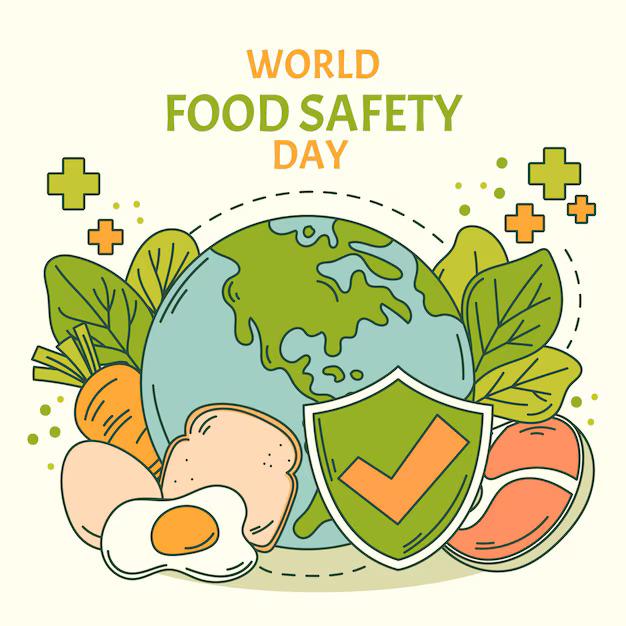Each year on June 7, the world observes World Food Safety Day, a global initiative spearheaded by the World Health Organization (WHO) and the Food and Agriculture Organization (FAO) of the United Nations. The purpose of this day is to raise awareness and inspire action to prevent, detect, and manage foodborne risks, contributing to food security, human health, economic prosperity, and sustainable development.
As our food systems become increasingly complex and interconnected, ensuring food safety is more important than ever. The theme for World Food Safety Day 2025, "Food Safety: Prepare for the Unexpected," emphasizes the importance of being prepared for food safety incidents, whether caused by contamination, natural disasters, or global supply chain disruptions.
What Is Food Safety?
Food safety refers to handling, preparing, and storing food in a way that prevents foodborne illness. It encompasses a broad range of practices and policies designed to ensure that food is free from contaminants, such as harmful bacteria, viruses, parasites, or chemical substances. The ultimate goal is to protect consumer health and promote confidence in the food supply.
Globally, 600 million people fall ill each year after consuming contaminated food, and 420,000 die, according to WHO estimates. Children under five are especially vulnerable, accounting for 125,000 deaths annually due to foodborne illnesses. These staggering numbers reveal that food safety is not only a health issue but also a major development challenge.
Why Food Safety Matters
Safe food is critical to sustaining life and promoting good health. Beyond health, food safety has implications for:
-
Economic growth: Unsafe food damages brand reputations, causes trade disruptions, and results in financial losses for producers and businesses.
-
Food security: Unsafe food undermines consumer trust and reduces access to nutritious, affordable foods.
-
Sustainable development: Food safety supports SDG 2 (Zero Hunger), SDG 3 (Good Health and Well-being), and SDG 12 (Responsible Consumption and Production).
In our globally connected world, a food safety incident in one country can rapidly become an international emergency. The recent rise in food recalls, outbreaks of foodborne illnesses, and concerns about pesticide residues or antibiotic resistance underscore the need for robust food safety systems.
Global Food Safety Challenges
1. Climate Change
Climate change is affecting agricultural conditions and food production. Warmer temperatures and unpredictable weather patterns can increase the presence of foodborne pathogens like Salmonella and E. coli. Flooding can contaminate crops with sewage or industrial waste, while droughts may concentrate toxins in food supplies.
2. Globalization of Trade
Food is often produced in one country, processed in another, and consumed elsewhere. This international trade introduces complexity to food supply chains and raises the risk of cross-border contamination.
3. Antimicrobial Resistance (AMR)
The overuse of antibiotics in animal farming is leading to resistant strains of bacteria that can be transmitted through the food chain. AMR is considered one of the top global public health threats, complicating the treatment of foodborne infections.
4. Misinformation and Consumer Behavior
In the age of social media, misinformation about food safety spreads quickly. False claims about preservatives, additives, or genetically modified foods can lead to unnecessary fear or unsafe practices.
Preparedness: The 2025 Focus
The theme "Prepare for the Unexpected" calls for greater readiness across all sectors to prevent and respond to food safety incidents. Whether it's a product recall, a supply chain interruption, or contamination after a natural disaster, being prepared saves lives and reduces harm.
Governments, food businesses, and consumers must work together. Preparedness involves:
-
Early warning systems and traceability tools.
-
Emergency response protocols.
-
Public communication strategies.
-
Investment in food safety infrastructure and training.
Roles and Responsibilities
Food safety is a shared responsibility. It involves everyone—from farmers and manufacturers to retailers, health authorities, and consumers.
● Governments
Set food safety standards, monitor compliance, conduct risk assessments, and manage foodborne outbreaks. Strong policies and enforcement mechanisms are essential.
● Food Producers and Businesses
Must ensure hygienic practices, conduct hazard analyses, label products accurately, and take corrective actions when issues arise. Implementing Good Manufacturing Practices (GMP) and Hazard Analysis and Critical Control Points (HACCP) is key.
● Consumers
Can protect themselves and their families by practicing safe food handling at home:
-
Wash hands and surfaces regularly.
-
Separate raw and cooked foods.
-
Cook food to safe internal temperatures.
-
Refrigerate perishables promptly.
-
Stay informed and read food labels carefully.
Conclusion
On World Food Safety Day, we are reminded that every meal we eat depends on a vast, interconnected system working together to keep food safe. Food safety is not an abstract issue—it affects what we eat every day and how healthy our communities can be.
By raising awareness, strengthening systems, and preparing for the unexpected, we can reduce the burden of foodborne diseases and create a safer, healthier future for all. Let us all take a moment today to consider the journey our food takes, and how we each play a part in ensuring that journey is a safe one.

